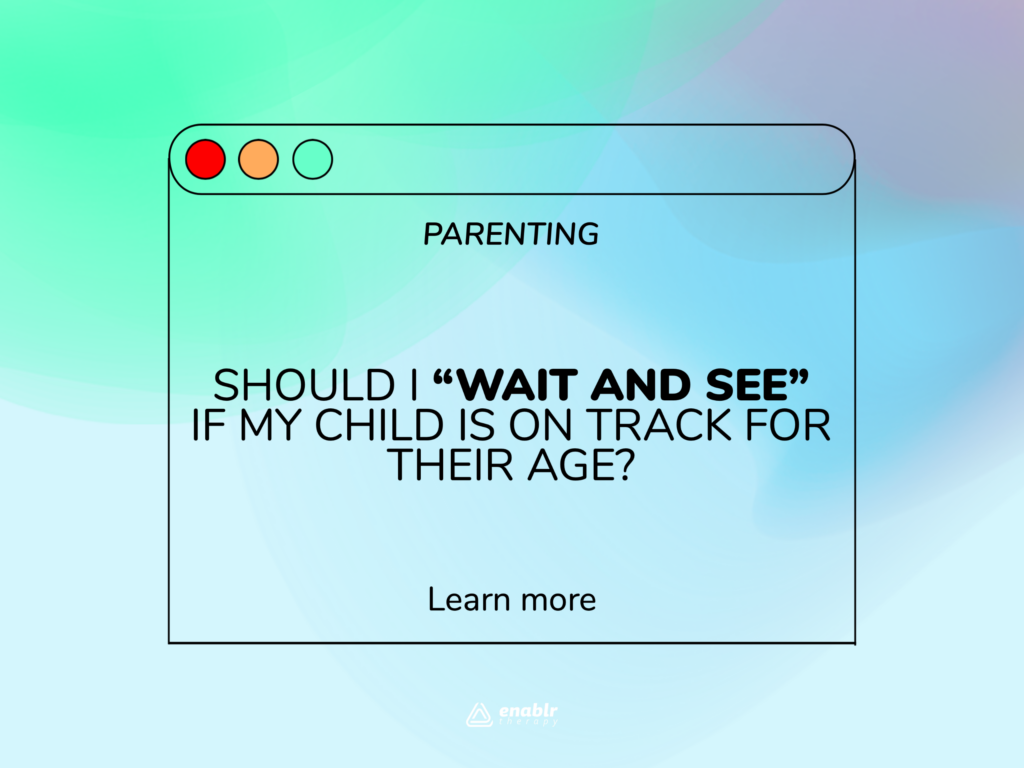
As parents, we’ve all been there, “wait and see,” playing the comparison game to determine if our child is on track with hitting all of their language milestones. These targets are ranges, meant to serve as a guideline of where most children will fall at any given age. When you begin noticing differences in your child’s speech compared to their peers, it’s hard to know what the next best steps are for addressing your concerns. Bringing this up to the pediatrician is the typical route for seeking guidance, but what do you do when you are met with the advice of “Let’s wait and see,” “he’ll grow out of it,” or “she’s just a late talker?”
Wait and See or Take Action
Figuring out if your child will eventually catch up to their peers is hard to predict. However, if your child demonstrates these risk factors, it is suggested that a child is more likely to have continuing language difficulties[2]:
- quiet as an infant; little babbling
- a history of ear infections
- limited number of consonant sounds (eg. p, b, m, t, d, n, y, k, g, etc.)
- does not link pretend ideas and actions together while playing
- does not imitate (copy) words
- uses mostly nouns (names of people, places, things), and few verbs (action words)
- difficulty playing with peers (social skills)
- a family history of communication delay, learning or academic difficulties
- a mild comprehension (understanding) delay for his or her age
- uses few gestures to communicate
It has been found that children who demonstrate the final three risk factors above (family history, comprehension problems, or few gestures) are at greatest risk for a continuing language delay [1]. If your toddler has a limited vocabulary for their age and any of the above risk factors, it’s time to consult with a speech-language pathologist. Instead of adopting a “let’s wait and see” approach advocating for early intervention is key.
How to Promote Communication
Now that you’ve identified it’s time to take action, there are also things you can start doing right now to get your child communicating. Below are some of Enablr Therapy’s top tips for promoting communication and language in young children.
E- Eye Level
Get on your child’s level when communicating with them. This allows you to pick up on non-verbal communication cues such as body language which in turn makes it easier to listen to and understand what they are saying.
N- Not just nouns
Focus on all words rather than just pointing and labeling nouns (Think: truck, tree, house, dog, mom). In order to grow a child’s vocabulary, we have to start introducing action words, pronouns, prepositions, descriptors, and more. A good way to target this is by communicating everything you are doing not only in your daily routines but during play time as well.
A- Avoid pressure
Are you finding yourself asking a ton of questions to try to get your child to respond? Putting pressure on a child to respond to questions or to communicate can actually have the opposite effect and hinder their desire to speak. When we add the expectation of communication through excessive questioning or requests such as “what’s this?” or “say _____,” it limits language opportunities.
B- Breathing-Space
As parents, it’s easy to ask our child a question or make a comment then jump in right away with a response. Toddlers need more time to formulate a response. Pause. Give them at least 7-10 seconds to respond instead of answering for them.
L- Lengthen
To increase a child’s vocabulary, we want to take what they say and add details to create a complete sentence. Ex. if they say “dog,” we would lengthen their communication with details, “oh wow, the little brown dog is running.”
R-Repeat
Copy the words, sounds, or gestures they use. Say words multiple times when interacting with objects or people. Contrary to what you may have heard growing up, sounding like a broken record is actually a good thing when it comes to language development.
If you have concerns about your child’s communication skills, go to our Therapy Services page to learn more. Enablr Therapy has a team of talented speech language pathologists that can work with your child and family to promote speech and language skills and help your child reach their full potential.
References
- Ellis, E. & Thal, D. (2008). Early Language Delay and Risk for Language Impairment. Perspectives on Language Learning and Education, 15: 93-100.
- Olswang, L.B., Rodriguez, B. & Timler, G. (1998). Recommending Intervention for Toddlers With Specific Language Learning Difficulties: We May Not Have All the Answers, But We Know a Lot. American Journal of Speech Language Pathology, 7, 23 – 32.


